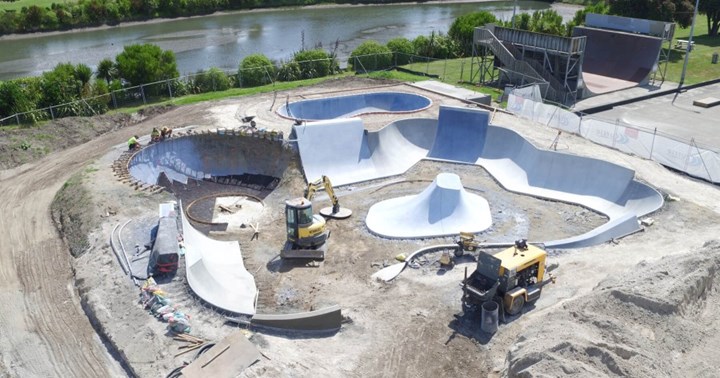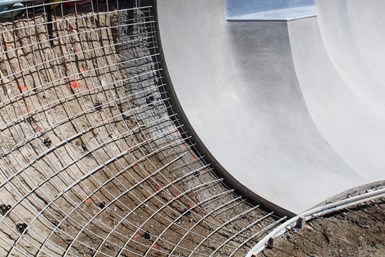Pultron Composites implements flexible composite rebar for skate park construction
The $2.6 million redevelopment for a skate park in Gisborne, New Zealand, reinforced its concrete with GFRP rebar, which easily bent to accomodate complex curves and improved construction times.

Photo Credit, all images: Tairawhiti Adventure Trust
The $2.6 million redevelopment of a much-loved skate park in Alfred Cox Park located in Gisborne, New Zealand is setting new design and construction standards nationwide, according to Pultron Composites (Gisborne, New Zealand).
The composites company supplied its Mateenbar glass fiber-reinforced (GFRP) rebar for the project from its Gisborne facility, replacing traditional steel rebar. The materials, which reportedly provided an advantage in terms of light weight and flexural bending for concrete reinforcement, resulted in a park suitable for high-performance athletes.
“It's easy to bend into corners, easy to stay in place. Once we learned how to use it properly we were away. We’ll definitely be looking to use it on future skatepark projects,” says Angus McMillan of AMC – Skatepark Construction Ltd., which specializes in constructing skate parks all over the country.

GFRP rebar used to reinforce the skate park’s concrete.
Composite rebar is used in a range of projects including bridges, roads and industrial projects, Pultron notes (like this marina construction and flood mitigation channel), but has also proven suitable for specialist projects. Rebar is corrosion resistant, requires less concrete coverage, is easy for installation and needs less maintenance.
In addition, Pultron says its ability to flex into large radius curves made it ideal for use in the Gisborne Skate Park Redevelopment, which required a certain amount of flexibility to ensure the curves and falls blend seamlessly. Further, because it’s easier to lay up, the time in which it was completed was faster.
The community project was the vision of the , which also acted as project manager alongside Shane Kingsbeer. The project also involved skate park design specialist , , (Arlington, Wash., U.S.) and Clark Structural Engineering (Selah, Wash., U.S.)
Related Content
-
Multi-scale 3D CT imaging enables digital twinning, high-fidelity simulation of composite structures
Computed tomography (CT) provides highly accurate 3D analysis of internal microstructure, performance simulation of carbon fiber/PEEK satellite strut.
-
Testing to support composite bolted joint analysis
An overview of ASTM Standard Guide D8509, and its coupon-level mechanical testing of design properties for analyzing composite bolted joints.
-
Improving carbon fiber SMC simulation for aerospace parts
Simutence and Engenuity demonstrate a virtual process chain enabling evaluation of process-induced fiber orientations for improved structural simulation and failure load prediction of a composite wing rib.






